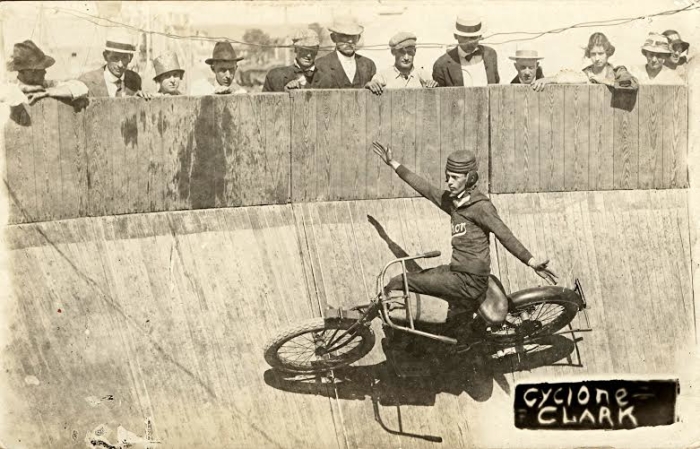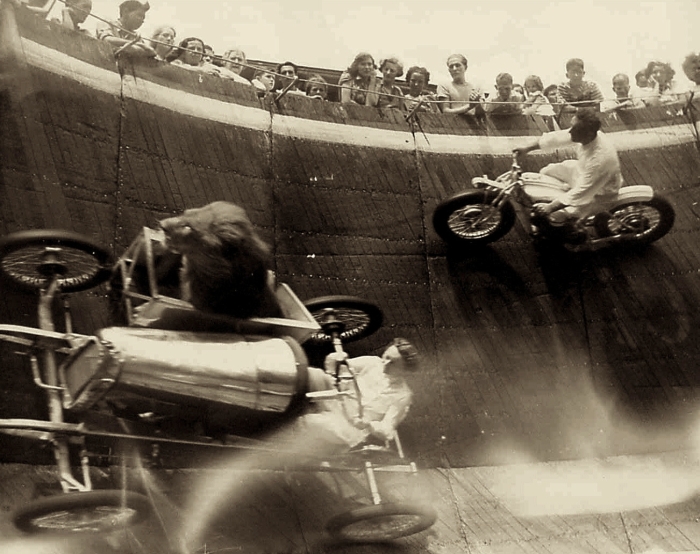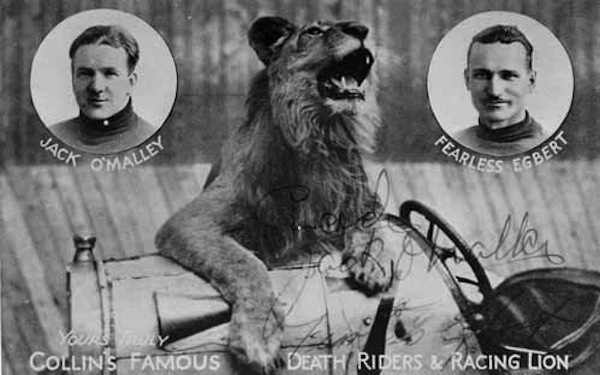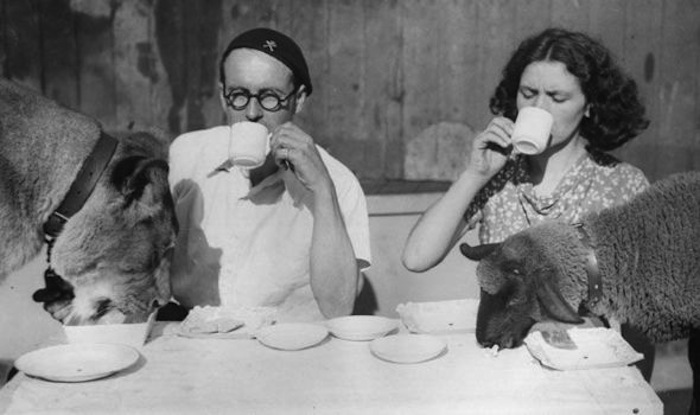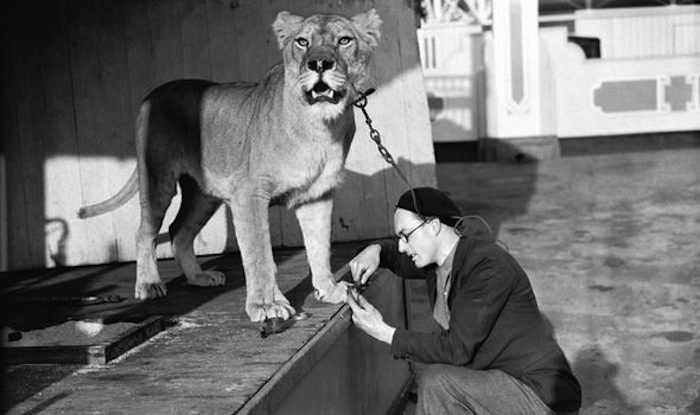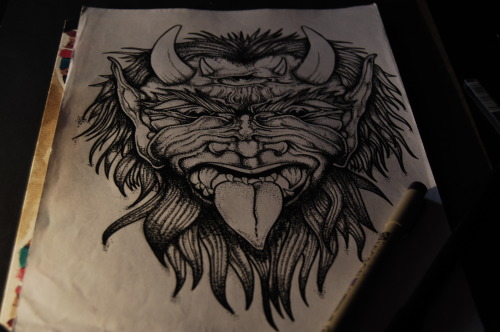
Shared posts
THE WALL OF DEATH RIDERS PT. II | LION TALES OF FUMES, FURY & FUR
TSY recenty received a scan of this great old Wall of death rider, along with the below note from the sender, Brian in Kansas City, MO. Anyone with knowledge of the rider, and/or this particular Wall of Death motordrome is kindly asked to chime in:
“…I am a collector of postcards and a while back I purchased a postcard of a man on a motorcycle riding in some kind of spectator show. Your article helped clarify a lot about the photo. I have attached the photo and thought maybe you have seen it before or could provide some more info. The back of the card is particularly interesting. It reads: ‘About 1912– Later he was killed– Someone threw a peanut at him– caused him to dodge and lose balance, falling with cycle to bottom of pit killing him.’ Sounds likes sport spectators were not much different then as they are today. I thought maybe the motorcycle may have been a Cyclone, however I don’t think it is. The lettering on his shirt may bring some clue as well…”
Back In Dec. ’09 TSY posted what remains today one of our more popular stories– Wall of Death riders with a lion, no less. I mean, really…old photos of a lion riding the Wall of Death is damn hard to beat…unless you have a video of said lion riding the Wall of Death! At that time there wasn’t a moving image to be found, but British Pathe, an amazing archive of historic film clips, uncovered a little gem of ‘Fearless Egbert’ giving his lion named Monarch a spin back in 1934. They also uncovered incredible film footage of ‘Tornado Smith’ with his Lion, ‘Briton’. It’s definitely worth a look…
.
Circa 1929, Wall of Death, Revere Beach, MA
“Fearless” Egbert of Collins Famous Death Riders & his racing lion named Monarch. via
.
“Fearless” Egbert taking his five year-old lion Monarch for a ride on the Wall of Death at Mitcham fair. via
Yorkshire Evening Post on September 24, 1931, Egbert & Monarch the Lion’s special relationship:
“It is remarkable how even lions can become civilised. Three years ago, Monarch, the lion that will ride on a baby car around a wall at Woodhouse Feast, had never seen a motor-car. His grandfather roamed the jungle and his father was captured and trained to ride a horse in an American circus. Then, just over three years ago, Monarch came along, and, on seeing a baby car which is driven by ‘Fearless Egbert’ round the Wall of Death, clambered into it. When he was given a ride he enjoyed it so much he refused to get out.”
“Obviously he was destined for a motoring career, and going one better than a mere rider of horses, Monarch was gradually introduced to the thrills in a car around a vertical wall. A ledge was fixed to the side of the car, and there was never any need to coax him to sit on it. He hopped aboard as soon as he was released from his cage, and snarled and growled if the driver had any difficulty in starting.”
“Nowadays, Monarch is driven round the miniature track at speeds that would make his more sedate father gasp. If Fearless Egbert stops the car too soon, the young lion remains on the car. There are times however, when he gets a little bored, and the driver knows it is time to stop when he realises that Monarch’s head is very close to his face.”
The report adds: “The owner of Monarch (said the) lion has never been strapped on the car. He jumped on it when he was three weeks old and now has thousands of miles of motoring to his credit.”
“Like all good people who occupy the limelight, he is rather sensitive about the way the show should be run. Fearless Egbert is the only driver who is allowed to take the wheel when Monarch is about; attempts by others arouse only growls, and Monarch’s tail whisks like a whip.”
“What is more, he is troubled like other stars, about his weight. Monarch could sit in comfort on the ledge when he joined the show, but since then his cage has twice had to be enlarged. Now he weighs about 350lb and he has to park part of himself on the bonnet of the car. Still, an attempt is being made to keep his weight down. On Sundays he dispenses with beef for dinner, and has milk and eggs.”
via the Yorkshire Evening Post
Tornado Smith, the Wall of Death rider from Southend, and his wife, Marjorie Dare, having tea with their pet lion and lamb. George “Tornado” Smith brought the Wall of Death from America to England in 1929, and featured such spectacles as”Briton the Wall-riding lion” and “Gymkhana Girls and Girl Protégées” in his billing. Check out the skull-and-crossbones badge on his beret, he’s nowhere near as mild-mannered as he looks. –Derek Berwin/Hulton Archive via
Curious tale of the Wall-of-Death hero who buried his lion sidekick outside a rustic villa:
“YOU DO KNOW that there’s a lion buried outside, in that courtyard, don’t you?” asked one of the regulars, just as I was leaving a quiet country pub.
I didn’t. It was early on a December afternoon in Boxford, Suffolk, that I accidentally stumbled upon the story of an almost-forgotten Great British eccentric, Tornado Smith, a Thirties Wall-of-Death stunt motorcyclist.
The village of Boxford is chiefly known for having hosted some good jazz concerts in recent years at the Fleece, one of its two pubs. It was, however, from its other hostelry, the White Hart, that the tale of the stunt rider and his pet lion emerged. The lion, actually a 12-stone lioness named Briton, had been part of George “Tornado” Smith’s Wall-of-Death act during the Thirties. As a cub, she had initially ridden on the handlebars of his Indian Scout motorbike. Once she was fully grown, she rode in a sidecar, while he performed daring stunts for his audiences.
Nowadays, we just don’t produce eccentrics of such calibre. George Smith was born in June 1908 in the Suffolk hamlet of Newton Green, near Boxford itself. His parents, already in the pub trade, took over the White Hart in 1921, which they ran until the early Fifties. George was a nervous child, so afraid of his teachers that his concerned mother once sought help for him. Despite this, the boy reportedly got himself into trouble, performing daredevil high-speed stunts with a soapbox cart, for which he was caned. He left school at 14, having been apprenticed to a local wheelwright.”
“He didn’t settle, however. By the age of 17, he was driving a lorry for a coal merchant. Shortly afterwards he became, variously, an AA patrolman and a taxi driver. It was during the latter job that Smith, dropping off a fare in Southend, happened upon his first Wall-of-Death. It seems to have been love at first sight. The fairground amusement had been recently imported from America. It comprised a giant drum, 20-feet high, lined with short, wooden boards around which stunt motorcyclists rode at speed, almost at 90-degree angles to the floor, their exhausts roaring and popping as they did so.
Spectators who paid to stand on a parapet surrounding the top of the drum would feel the whole structure move as they looked down upon the motorcyclists racing around below them. There were occasional injuries and tumbles although, strangely, it’s now claimed that no deaths were ever attributed to the Wall-of-Death. An equal opportunities concept from the very beginning, the stars of the Wall were just as likely to be women as men.
Having become obsessed with the idea of being a stunt rider, the young Suffolk lad began applying for jobs. He was unsuccessful, until the boss of a new Wall-of-Death, at an amusement park in Whitley Bay, near Newcastle gave him a job as a mechanic. Here he gained a chance to perfect his own act. In September 1930, aged 22, George was taken on by a touring company and made his debut as “Tornado” Smith in Malmo, Sweden.”
Circa 1936, Southend-on-Sea, England — Mr. “Tornado” Smith, a stunt motorcyclist on the Wall of Death, clips the toenails of his pet lion, Briton, at home. — Image by © Hulton-Deutsch Collection
“Upon his return to Britain, during a short run of work for Bertram Mills Circus, Tornado met the woman he would eventually marry. A pretty teenager, then working as a cosmetics sales assistant, Doris Craven fell head-over-heels for the charismatic stuntman. Slim of build, with a David Niven-style pencil moustache, he wore tortoiseshell spectacles and sported a jaunty beret. Doris, his new inamorata, a feisty young woman, wasted no time and soon learned to ride the Wall herself, settling upon the stage name Marjorie Dare. Tornado, a consummate showman, was always looking for new ways to bring customers into his shows. So it was that in 1933, he purchased Briton, the lion cub, intending to train her for his act.
Just in itself this part of the story illustrates how much circumstances have changed during recent decades. It seems impossible to believe now that anyone might have been able to easily acquire something as exotic as a lion cub. Up until as late as 1976, however, when the Dangerous Wild Animals Act was passed, almost anyone with the money to do so might have placed order via the Harrod’s department store an order via the Harrod’s department store in Knightsbridge.
A short British Pathe newsreel clip from the Thirties helps illustrate the whole incredible story. The clip opens with shots of Marjorie Dare walking a large lamb (actually almost a fully grown sheep) on a lead through a busy Southend street. Subsequent footage shows her swimming in the sea with the creature.”
“There follows footage of her husband parading his lioness around on a lead. The film ends with husband and wife alongside their lioness and lamb, all sat cheerily outdoors together, at a table sharing tea and cakes. Dubbed over the film is an unintentionally hilarious commentary, in the Cholmondley-Warner style of comedian Harry Enfield. The clip allows a window into the recent past, a world so different from our own that it seems almost Monty Pythonesque.
From a modern health and safety viewpoint, Tornado Smith’s lifestyle represents almost a perfect storm. Consider it: two motorcycle stunt-riders with little or no safety procedures, conducting performances in an unstable wooden structure into which unprotected members of the public are invited in order to view the spectacle from a parapet.
Now throw in a lioness being walked around on a lead and a sheep swimming at a public beach. There’s even more. With regard to his lioness, who was reportedly, somewhat fierce as a cub, Smith did actually have a contingency plan. In case she should ever turn on him during a performance, he always carried a loaded pistol. During their early married life, Tornado and Marjorie lived in Feltham, Middlesex, where the stunt man was frequently to be seen in the streets walking the lioness around. In the winter, the couple returned home to rural Suffolk. Here, they had set up the Wall-of-Death in the yard of his parents’ pub and performed for the locals’ amusement. Smith would take the lioness out on her morning constitutionals around the village streets.”
Circa 1949, UK — Tornado Smith helps Maureen Swift ride a motorcycle around the “Wall of Death” to promote BSA motorcycles. — Image by © Hulton-Deutsch Collection
“Sadly, Briton’s short life ended at the outset of the Second World War. A 12-stone lioness requires a fair amount of meat. With a prevailing meat shortage and what little there was now rationed by price, feeding her would have become economically unsustainable. Smith, probably short of money at this point, was left with little option but to shoot her. He buried her in the courtyard of the White Hart, where her remains have lain for more than seven decades. Smith’s glory days too, began to tail off towards the end of the Thirties.
During the war, he applied to become a fighter pilot but, rejected because of his poor eyesight, served instead in the Navy. It was during this time that his marriage to Marjorie Dare broke up.
Having heard their story, I wondered if there was anyone alive who might remember seeing Tornado perform and was fortunate enough to meet Ken Lazell, 81, himself a former motorbike enthusiast from Benfleet, Essex. ‘Tornado Smith? Of course I remember him,’ he said. ‘I’d go and watch him in Southend. The riders came so close to the top of the parapet, that you could have leaned down and touched their heads.’
Remarkably, Smith continued to entertain spectators at Southend right up until the mid-Sixties. He retired from the Wall in 1965, having spent his last years struggling somewhat. In a new era of ever more spectacular stunts conducted by formation motorcycle teams, the heyday of the Wall-of-Death artistes had passed. Tornado retired, firstly to Spain and finally to South Africa, where he died in 1971 aged 63. He’s not entirely forgotten, however. A Suffolk micro-brewery, Mill Green, not far from Boxford, recently brewed a beer commemorating the motorcycling legend.
Tornado Smith, appropriately enough, is described as ‘an eccentric pale ale’.”
Phil America's The Nefarious Face of Chinatown
Tiagogrim


Here's more about the exhibit:
Over the course of 30 days he spent nearly every day in Bangkok's Chinatown, betting on Fan-tan and Hi-lo with the old men and got tattooed with a magical sak yant tattoo by a master. He built relationships with prostitutes outside the tea shops, painted fake license plates and put together knock-off Louis Vuitton bags with local workers. He even spent a day with a young gang members riding around dropping off fake Valium and Viagra to shops around Bangkok. During the process he gathered artifacts relating to the neighborhood and it's crime, some of which were confiscated by the law-firm owning the rights to Rolex and by the Danish police.See more photos from the show here. Also check Phil America's blog.
The series of photos shows a strong, underlining strength in the eyes of the pimps and drug lords and contrasts that with the tattooed hands of the criminals on the street. Phil America takes his time to show that, here, the face of the criminals and crime itself are both honest and nefarious.
[Via Susannah Breslin.]
Tattoos of Algeria

In addition to a great slideshow of the edler generation of the Amazigh, or Berber tribe, there are some personal stories of these tattooed women, which make it a must-read. Here's a taste:
The tattooing practice in particular has ceased for more than half a century already, with Roqaya's generation the last to be tattooed, in the 1930s and 40s. Tattoos have been documented throughout the Middle East and North Africa for thousands of years: painted on Egypt's Tomb of Seti, noted in the writing of pre-Islamic poet Tarafa Ibn Alabd in what is now Turkey and in the 1935 anthropological expedition of Winifred Smeaton in Iraq.
In the Aures Mountains, the tattoos were considered enhancers of beauty when applied to the face and had therapeutic and healing purposes - particularly related to fertility - when found elsewhere on the body, such as above the ankle or on the back of the hand. For men, traditional tattoos were far less ornamental and served healing purposes.
Today, tattooed women say Islam's prohibition of tattooing is the primary reason for the loss of the tradition, along with changing perceptions of beauty and the disappearance of the adasiya, a wandering gypsy tattooist.
Read more here.
